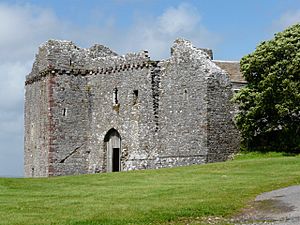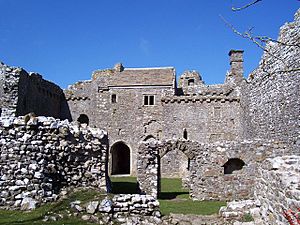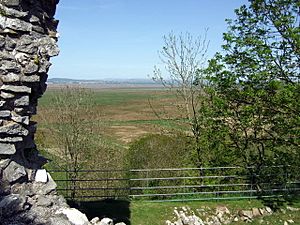Weobley Castle, Gower facts for kids
Quick facts for kids Weobley Castle |
|
|---|---|
| Native name Welsh: Castell Weble |
|
 |
|
| OS grid reference | SS 47819 92732 |
| Built | 1304-1327 |
| Built for | de la Bere family |
| Lua error in Module:Location_map at line 420: attempt to index field 'wikibase' (a nil value). | |
Weobley Castle (say "weblee") is an old fortified manor house from the 14th century. It is located on the Gower Peninsula in Wales. Today, Cadw looks after it. The castle sits high up, looking over the Llanrhidian saltmarshes and the Loughor estuary.
Contents
Exploring Weobley Castle
Most of the castle you see today was built between 1304 and 1327. This was done by the de la Bere family. The castle has a main entrance, a large hall, a kitchen, a chapel area, and an east wing. These parts surround a central courtyard. Most of the castle is now in ruins, meaning it is partly broken down. The buildings are mostly made from rough stones called rubble masonry. The windows and doors are made from sandstone.
Main Entrance and Towers
The main entrance, or gateway, is on the west side of the castle. To the north of the gateway is the solar block. This was like a private apartment for the lord of the castle. It had his own room, a private toilet (called a latrine), and a storage space downstairs.
To the south of the gateway is the Cistern Turret. People think this tower held a cistern, which is a tank for storing rainwater. Behind this is the South-West Tower. This tower might be the oldest part of the castle. The gateway itself also had a living room on its upper floor.
The Great Hall and Other Rooms
The northern part of the castle is the strongest section still standing. This includes the great hall, the kitchen, and a porch leading from the inner courtyard. The hall has a special space where tapestries or wooden panels might have been displayed. This shows that Weobley Castle was more of a fancy home for a rich family than a military fort.
During digs at the Chapel Block, small pieces of a piscina were found. A piscina is a stone basin used in churches for washing holy items. The eastern part of the castle is more broken. It might not have been fully built by the de la Bere family. Even though most of the outer walls are gone, the castle had many guest rooms. It also had facilities like garderobes, which were more toilets. The castle was made bigger later in the 14th century, with a new south porch added.
A Look Back in Time: Weobley's History
For many years, until the 15th century, Weobley Castle was home to the de la Bere family. They were originally helpers to William De Braose, who was the Lord of Gower. We know the castle was important because a document was signed there in 1318 by Adam de la Bere.
Attacks and New Owners
In the early 15th century, the castle was attacked by the forces of Owain Glyndŵr. He was a Welsh leader who fought against English rule. The castle was damaged, but most of it stayed standing. It is possible that John de la Bere, who died in 1403, was harmed during Glyndŵr's attacks.
Later, Sir Rhys ap Thomas became the owner of the castle. This was towards the end of the 15th century. However, his grandson, Rhys ap Gruffydd, faced serious trouble and lost his life in 1531. After this, Weobley Castle became property of the King, Henry VIII.
From Royal Hands to Public Care
The King then sold the castle. After that, it was rented out to different people for many years, until the 20th century. The last private owner was Emily Talbot. In 1911, she gave Weobley Castle to the state. This means it became public property, and now Cadw looks after it for everyone to enjoy.



